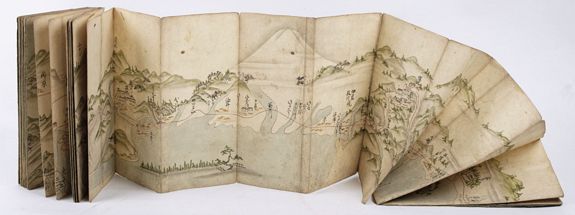‘Tosai Kairiku no Zu’ [Route map of Japan from East to west by land and sea]

ANONYMOUS (Japan, 1800 - 1830) 270 x 8000 mm / 10.6 x 315 inches. Horizontal scroll, pen, and ink with watercolors on rice paper. Presented in concertina form with paper covers, modern cloth case. Size of book block 270 x 120mm.
A fascinating and rare 8 meters horizontal
scroll painting illustrating the "Tosai Kairiku no Zu" being a route map
of Japan from East to West by land and Sea. This type of road map is
much rarer than the Tôkaidô Road which includes only the western part of
the Japanese islands.
The scroll begins with the illustration of Edo Castle and ends with the port and city of Nagasaki.
Sold
A particularly fine calligraphy in Japanese “kuzushiji, 崩し字", readable in our days only by specialists: an exceptional art work preserved in very good condition.
Undated, ca. 1800 - 1830, based on the date of name changes occurring in the indicated period of time.
Hundreds of name places portrayed, many of them no longer on modern maps because of name changes during the centuries.
The scroll begins with the illustration of Edo Castle, 江戸御城, the residence of the Tokugawa Shôgun until 1868. After the Meiji Restoration it became the Japanese Imperial Palace.
Distances between the named places are often given in Ri (1 Ri, 1 里, ca. 4 km). Castle towns, tea houses, (Ochaya, 御茶や), rivers, islands, bridges and mountains are portrayed and named on the road. Road travelers and a few small sailing boats on Japan's sea shore are also shown embellishing the scroll.
The first place named on the road is Atago, 愛宕, where a Shintô shrine with its characteristic red gate is shown. Then, attention is drawn to Zôjôji, 増上寺, a Buddhist temple and to Shinagawa, 品川, the starting point of the famous Tôkaidô Road, connecting Edo with the Imperial Capital Kyôto, immortalized by many novels and Hiroshige's beautiful prints showing the 53 stations where shelter was given to the travelers.
From the innumerable names on the scroll a selection of castle towns and important names follow here: Hakone, Hamamatsu, Yoshida, Okazaki, Nagoya, Ôgaki, Sekigahara (the famous battlefield at the origin of the foundation of the Tokugawa Shôgunate), Hieiyama (with the main temple of the Buddhist Pure Land sect), Daibutsu, (the term often used for large statues of Buddha), Sanjô (the famous bridge in Kyôto, corresponding to the 0 km, from which distances are measured from the imperial capital), Dairi (大裏, the Imperial Palace, Kyôto), Tôji, (東寺 or Eastern Temple, a Buddhist Temple of the Shingon sect in Kyôto's centre.
Further names on the scroll are: Fukuoka, Kumamoto, Shimabara, (In the wake of the rebellion of Japanese Christians in 1637, the catholic religion was prohibited in Japan until 1850), Nagasaki (the single city open to trade with the Dutch merchants and the city from where western science was introduced to Japan), Hirado, 平戸, the beautiful island where the English merchants were staying between 1600 – 1613 and the Dutch until their transfer in 1639 to Dejima island in Nagasaki's, 長崎, port.
Literature: Chiba, Reiko. Hiroshige's Tokaido in Prints and Poetry. Tuttle. (1982) , Taganau, Jilly. The Tokai do Road: Travelling and Representation in Edo and Meiji Japan. RoutledgeCurzon (2004). Kadokawa Chimei Daijiten, 1970 – 1980.